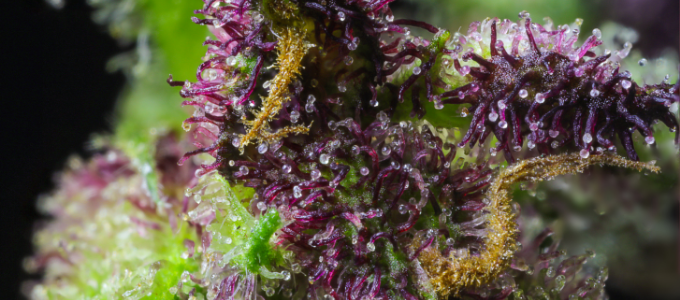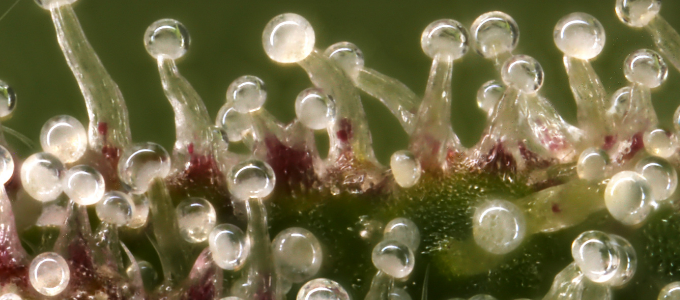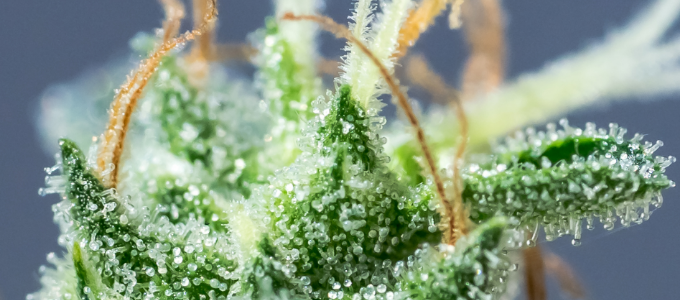
If you’ve ever looked at a piece of cannabis bud closely, chances are you’ve seen the layer of frost-like crystals covering the leaves and stems of the flower. But just what are trichomes and what do they do?
That frost-like substance is also known as Trichomes -- they are tiny biological cannabinoid epicenters found on the flowers and leaves of cannabis plants.
They’re a treat for the weed lover’s senses as they tend to be shiny, sticky, and emit a variety of aromas depending on the strain.

Trichome is defined as “fine outgrowths or appendages on the epidermis of a plant,” and they can be observed in a variety of plant species throughout nature. Originating from the Greek word “Tríchōma,” meaning “growth of hair,” trichomes are small resin glands that look like tiny hairs with a round and bulbous tip. They range in 10 to 100 micrometers and give marijuana buds their frosty, shiny, and sticky appearance.
Trichomes serve many different functions for plants such as keeping them safe, healthy, and functional. In Cannabis, trichomes function as protection from difficult climate and outside elements such as harmful UV rays, strong winds, and fungal growth.
Trichomes also deter animals and insects away from the marijuana plant by emitting a strong aroma and bitter taste.
Trichomes manufacture the hundreds of cannabinoids, terpenes, and flavonoids that make each cannabis strain potent and unique. They are an essential part of the cannabis plant and without them, there wouldn’t be any THC, CBD, terpenes, or extracts for weed enthusiasts to enjoy.

Three types of Trichomes appear most often on cannabis plants. However, it is the third group that catches the weed lover’s attention.
Bulbous Trichomes
Capitate sessile Trichomes
Capitate-stalked trichomes
Capitate-stalked trichomes appear in abundance around the calyxes of budding flowers. They also measure much larger than their counterparts and is visible to the naked eye. Due to their size, capitate-stalked trichomes produce the highest concentration of essential oils -- from which all your favorite oily medicinal and recreational goodies are made.
Although trichomes do produce cannabinoids, plants containing higher concentrations of trichomes don’t always produce high concentrations of cannabinoids. Factors such as UV light can impact the rate of cannabinoid and terpene synthesis. Usually, plants exposed to a broader spectrum of light will produce more cannabinoids and/ or terpenes, however, this can be strain specific.
To simply put it, yes.
To further break it down, the compounds THCA and CBD are found within the trichomes of a cannabis plant. They are then heated and undergo a chemical reaction, producing the medicinal and psychoactive properties of your favorite strains.
During combustion, THCA is converted into THC. When you consume marijuana, THC interacts with the cannabinoid receptors found in the brain resulting in the ‘high’ feeling we get after consuming cannabis.
Cannabis concentrates and extracts including hash, shatter, cannabis oil, and wax all rely on trichomes that are harvested from cannabis plants. Weed growers use a method referred to as ‘solvent extraction’ to separate cannabinoids and terpenes from their plant tissues by using solvents such as ethanol and isopropyl alcohol.
All solvents must be completely removed before cannabis extracts are safe to use.
There are other methods to collect extract without the use of solvents. Rosin, can be made by pressing dry cannabis flower between heated metal plates. While hash, on the other hand, can be made through various methods including the water/ice method and hand rolling.

Most growers examine their plants with magnifying glasses, making it easier for the naked eye to see developing trichomes. Growers can also monitor the changes in their plants by analyzing their visual appearance and aroma. When it comes to harvesting trichomes, for most growers -- the denser the trichomes, the better. However, it’s really up to personal preference.
Early harvest offers a lively, energetic type of high. During this stage, trichomes will still appear clear and colorless and their yields are not yet at their peak.
Most growers wait until the majority of their trichomes (70%) start to turn cloudy in appearance, the high from this type of harvest is more profound with increased body effects.
Some growers choose to wait until most of the trichomes start to display an amber or reddish tint. The high from late-harvested trichomes can be heavy with strong body effects. In simpler terms, this is the type of weed that will get you couch-locked stoned.
When growing your own plants, the quality of your crop is heavily dependent on seed quality. Good quality cannabis seeds will result in a higher trichome production yield, resulting in a crop of high-quality cannabis. Environmental conditions also impact trichome levels on cannabis plants, many modern growers have switched to LED grow lights to help them cultivate the most THC from their crops.
Additionally, supplementing LED light with UVB light is another way to boost cannabis trichome production. This is a technique used by professional growers as the rate of trichome production increases as a defense to UVB radiation, so adding UVB will increase your trichome yield. UVB light can severely damage human eyes and skin, therefore it’s important to be extremely vigilant. Never look or enter any area where UVB lights are on.
With marijuana being legal in some capacity in more than half of the U.S. states, more people are leaning towards growing and harvesting their plants. To grow the best cannabis, high-quality seeds supplemented with an optimal growing environment are needed along with proper care and dedication.
The magic of cannabis is found within its trichomes, they are the prime source of the cannabinoids, terpenes, and flavonoids that characterize the quality and ‘high’ of our favorite cannabis strains. Without trichomes, the cannabis plant wouldn’t have its amazing healing and euphoric properties.











